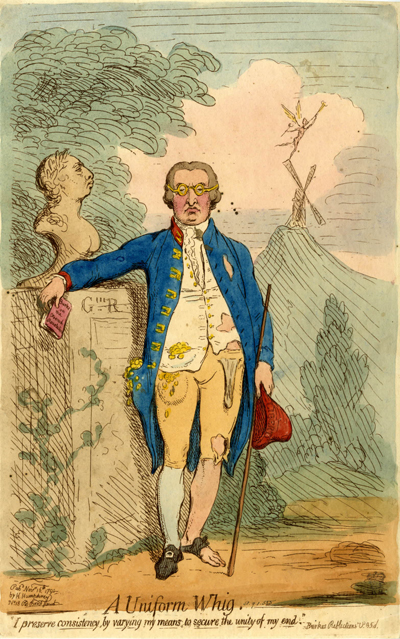A Uniform Whig
A Uniform Whig shows the anything but uniform Edmund Burke who, as part of the Whig opposition had seemed to be an active supporter of liberty during the American war for independence, but now, since the publication of his Reflections on the Revolution in France (1790) and his recent and quite public break with Fox, seemed to many of his contemporaries to have aligned himself with the King and Tories. Gillray's subtitle is drawn from the final peroration of Burke's Reflections where Burke argues that the opinions expressed there
come from one. . .whose public exertion has been a struggle for the liberty of others; . . . from one who wishes to preserve consistency; but who would preserve consistency by varying his means to secure the unity of his ends.
And Gillray is surely correct in noticing that those words reinforce the bifurcated image in his print by sounding suspiciously like double-talk.

© Trustees of the British Museum
The general context for Gillray's print was the flurry of articles that had appeared since Fox's charge of inconsistency in Burke's positions on the French and American constitutions. Some deplored what appeared to be Burke's "apostasy" from Whig principles; others justified Burke's position and argued for a truer and deeper consistency in his writings. One of these was, in fact, Burke's anonymously published reply to Fox's charge, An Appeal from the New to the Old_Whigs (1791).
But the immediate impetus was most likely the article which appeared on November 4th in the Morning Post and Daily Advertiser which reported that
Mr. Burke will soon be rewarded for his political apostasy and his desertion of his old friends....Mr. Burke, we are told, is to be created a Baronet, which together with the salary and emolument of a Receiver-General of the Customs, a clear three thousand per annum, must make him pretty comfortable—if apostasy like his is capable of comfort.
Gillray's print reflects this (ultimately false) report. The Old Whig Burke had always had a tough time making ends meet, so Gillray shows him with empty pockets and tattered clothes and shoes, holding a bonnet rouge inscribed with the word, "Liberty", while leaning on a pathetically weak-looking staff. The new Burke is handsomely clothed and shod, pockets literally overflowing with money, his right hand bearing a copy of his Reflections on the Revolution in France while "supported" by a solid plinth with a classical bust of King George.
The figure of Fame behind Burke blows one of two trumpets(?) in her hands from the top of a windmill, which may suggest the change from one persona to another and Burke's frequent appearance as Quixote in other prints of the time, as Nicholas Robinson suggests in his excellent, Edmund Burke: A Life in Caricature.
But it may also reflect Gillray's and by extension his audience's confusion about who Burke really is.
Sources and Reading
- Commentary from the British Museum on A Uniform Whig
- Nicholas K Robinson, Edmund Burke: A Life in Caricature, 1996
- "Edmund Burke," Wikipedia
- Thomas Wright and R.H. Evans, Historical and Descriptive Account of the Caricatures of James Gillray #70
Comments & Corrections
NOTE: Comments and/or corrections are always appreciated. To make that easier, I have included a form below that you can use. I promise never to share any of the info provided without your express permission.